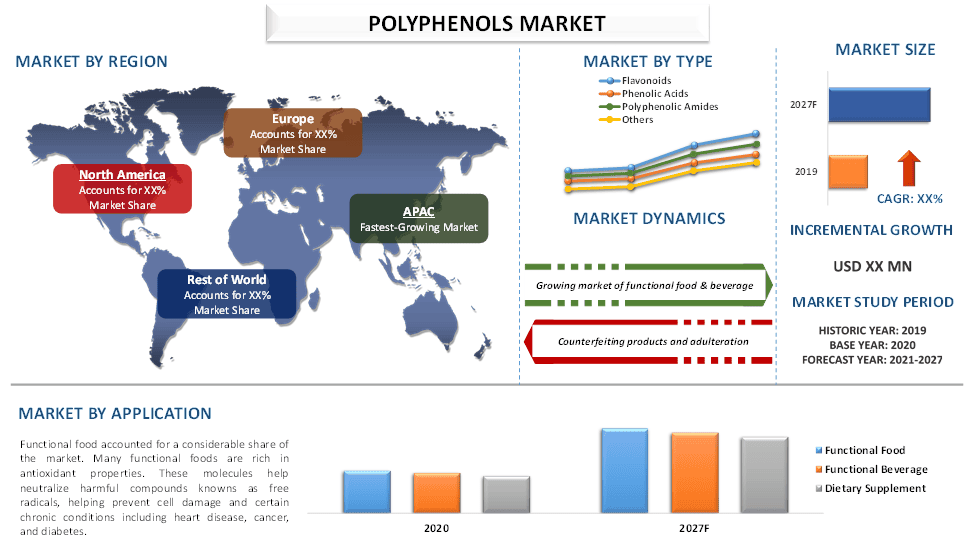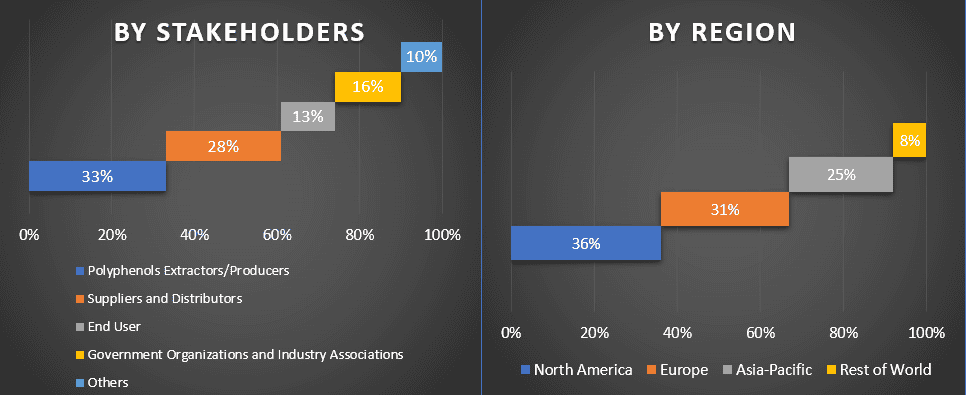- Home
- About Us
- Industry
- Services
- Reading
- Contact Us
Polyphenols Market: Current Analysis and Forecast (2021-2027)
Emphasis on Type (Flavonoids, Phenolic Acid, Polyphenolic Amides, and Others); Application (Functional Food, Functional Beverage, Dietary Supplement, Cosmetics & Toiletries, and Other); and Region and Country

The global polyphenols market stood at around USD 1.6 billion in 2020 and is likely to showcase a growth of around 5% during the forecast period. Polyphenols are micronutrients that occur in plants and are commonly used in protection against ultraviolet radiation or aggression by pathogens. Nowadays, they are included in many nutrition products although they are easy to get into your diet from foods like fruits, vegetables, teas, and spices. Several studies show that the consumption of polyphenols regularly offers protection against the development of cancers, cardiovascular diseases, diabetes, osteoporosis, and neurodegenerative diseases. As people are getting more serious about their health owing to rising health risks and increasing awareness regarding the benefits of living a healthy life, thereby increasing the demand for health-related products and supplements. This resulted in the increase in demand for functional food & beverages thereby fueling the extraction and consumption of polyphenols. According to International Diabetes Federation, around 537 million adults of age 20-79 years are living with diabetes and is likely to reach 643 million by 2030 and 783 million by 2045.
Insights Presented in the Report
“Amongst type, the flavonoids held a prominent share in the market in 2020.”
Based on type, the market is categorized into flavonoids, phenolic acid, polyphenolic amides, and others. Among these flavonoids accounted for a major share in the market and are likely to retain their position during the forecast period. This can be attributed to the vast range of fruits & vegetables which contains flavonoids. Examples include quercetin, kaempferol, catechins, and anthocyanins, which are found in foods like apples, onions, dark chocolate, and red cabbage.
“Amongst applications, the functional food category accounted for a considerable share in the global polyphenols market
Based on application, the market is categorized into functional food, functional beverage, dietary supplement, cosmetics & toiletries, and others. Out of these, functional food accounted for a considerable share of the market. Many functional foods are rich in antioxidant properties. These molecules help neutralize harmful compounds knowns as free radicals, helping prevent cell damage and certain chronic conditions including heart disease, cancer, and diabetes. Since polyphenols act as an antioxidant, therefore with increasing demand for functional food, the consumption of polyphenols in the application would increase.
“North America accounted for a considerable share in the global polyphenols market”
For a better understanding of the market adoption of Polyphenols, the market is analyzed based on its worldwide presence in the countries such as North America (United States, Canada, Rest of North America), Europe (Germany, UK, France, Italy, Spain, and Rest of Europe), Asia-Pacific (China, Japan, India, Australia, and Rest of APAC), and Rest of World. North America accounted for a significant share of the global polyphenols market. This can be attributed to the large functional food & beverage market. Further, the US is the largest market for the functional food & beverage industry owing to increasing awareness among the consumers regarding the benefits of these products coupled with the high disposable income of people.
Reasons to buy this report:
- The study includes market sizing and forecasting analysis validated by authenticated key industry experts
- The report presents a quick review of overall industry performance at one glance
- The report covers an in-depth analysis of prominent industry peers with a primary focus on key business financials, product portfolio, expansion strategies, and recent developments
- Detailed examination of drivers, restraints, key trends, and opportunities prevailing in the industry
- The study comprehensively covers the market across different segments
- Deep dive country-level analysis of the industry
Customization Options:
The global polyphenols market can further be customized as per the requirement or any other market segment. Besides this, UMI understands that you may have your own business needs, hence feel free to connect with us to get a report that completely suits your requirements.
Table of Content
Analyzing the historical market, estimation of the current market, and forecasting the future market of Polyphenols, three major steps are undertaken to create and analyze its adoption across the globe. Exhaustive secondary research was conducted to collect the historical market numbers and estimate the current market size. Secondly, to validate these insights, numerous findings and assumptions were taken into consideration. Moreover, exhaustive primary interviews were also conducted, with industry experts across the value chain of the Polyphenols industry. Post assumption and validation of market numbers through primary interviews, we employed a bottom-up approach to forecast the complete market size. Thereafter, market breakdown and data triangulation methods were adopted to estimate and analyze the market size of segments and sub-segments the industry pertains to. Detailed methodology is explained below:
Seek More Details About Research Methodology
Analysis of Historical Market Size
Step 1: In-Depth Study of Secondary Sources:
Detail secondary study was conducted to obtain the historical market size of Polyphenols through company internal sources such as annual reports & financial statements, performance presentations, press releases, etc., and external sources including journals, news & articles, government publications, competitor publications, sector reports, third-party database, and other credible publications.
Step 2: Market Segmentation:
After obtaining the historical market size of the Polyphenols market, we conducted a detailed secondary analysis to gather current market insights and share for different segments & sub-segments for major regions. The major segment is included in the report by type and application. Further regional and country-level analyses were conducted to evaluate the overall adoption of polyphenols globally.
Step 3: Factor Analysis:
After acquiring the historical market size of different segments and sub-segments, we conducted a detailed factor analysis to estimate the current market size of Polyphenols. Further, we conducted factor analysis using dependent and independent variables such as increasing demand for functional food & beverages and growing focus on high nutrients products. A thorough analysis was conducted for demand and supply-side scenarios considering an increasing investment, top partnerships, mergers and acquisitions, business expansion, and product launches in the Polyphenols industry.
Current Market Size Estimate & Forecast
Current Market Sizing: Based on actionable insights from the above 3 steps, we arrived at the current market size, key players in the global polyphenols market, and market shares of each segment. All the required percentage shares split, and market breakdowns were determined using the above-mentioned secondary approach and were verified through primary interviews.
Estimation & Forecasting: For market estimation and forecast, weights were assigned to different factors including drivers & trends, restraints, and opportunities available for the stakeholders. After analyzing these factors, relevant forecasting techniques i.e., the bottom-up approach were applied to arrive at the market forecast to 2027 for different segments and subsegments across the major regions globally. The research methodology adopted to estimate the market size encompasses:
- The industry’s market size, in terms of value (US$) and the adoption rate of Polyphenols across the major markets
- All percentage shares, splits, and breakdowns of market segments and sub-segments
- Key players in the Polyphenols market. Also, the growth strategies adopted by these players to compete in the fast-growing market.
Market Size and Share Validation
Primary Research: In-depth interviews were conducted with the Key Opinion Leaders (KOLs) including Top Level Executives (CXO/VPs, Sales Head, Marketing Head, Operational Head, Regional Head, Country Head, etc.) across major regions. Primary research findings were then summarized, and statistical analysis was performed to prove the stated hypothesis. Inputs from primary research were consolidated with secondary findings, hence turning information into actionable insights.
Split of Primary Participants by Stakeholders and Regions

Market Engineering
The data triangulation technique was employed to complete the overall market estimation and to arrive at precise statistical numbers for each segment and sub-segment of the global Polyphenols market. Data was split into several segments & sub-segments post studying various parameters and trends in the area of type and application.
The main objective of the Polyphenols market study
The current & future market trends of global Polyphenols were pinpointed in the study. Investors can gain strategic insights to base their discretion for investments on the qualitative and quantitative analysis performed in the study. Current and future market trends would determine the overall attractiveness of the market at a country level, providing a platform for the industrial participant to exploit the untapped market to benefit as a first-mover advantage. Other quantitative goals of the studies include:
- Analyze the current and forecast market size of Polyphenols in terms of value (US$). Also, analyze the current and forecast market size of different segments and sub-segments
- Segment in the study include the area of type and application
- Defined analysis of the regulatory framework for the Polyphenols industry
- Analyze the value chain involved with the presence of various intermediaries, along with analyzing customer and competitor behaviors of the industry
- Analyze the current and forecast market size of Polyphenols for the major countries
- Major regions/countries analyzed in the report include North America (US, Canada, Rest of North America), Europe (Germany, UK, France, Italy, Spain, Rest of Europe), Asia-Pacific (China, Japan, India, Australia, Rest of Asia-Pacific), and Rest of World
- Company profiles of the Polyphenols market players and the growth strategies adopted by them to sustain in the growing market
- Deep dive country-level analysis of the industry
Related Reports
Customers who bought this item also bought










